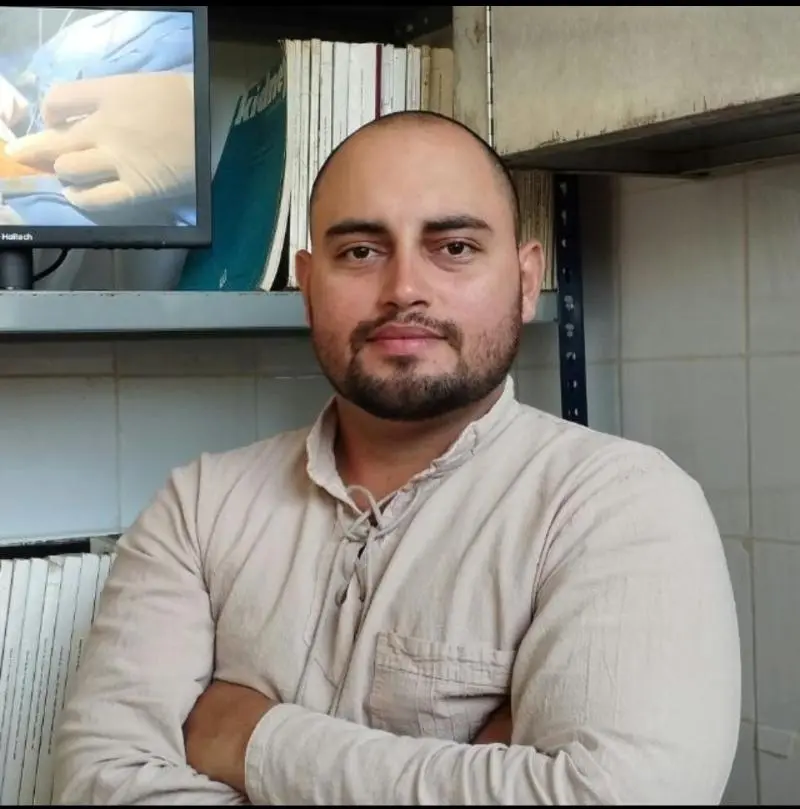
A singular opportunity for the development of an important specialty in the province of Holguin and the country was represented by the First Cuban Course on Interventional Nephrology, held at the Lucia Iñiguez Landin Clinical Surgical Hospital until September 15.
To learn more details about this field, which offers unquestionable advantages for both patients and professionals who practice it, the nephrologist who organized this event and fellow in Interventional Nephrology by the International Society of the specialty, Dr. Lázaro Ibrain Cobiellas Carballo, shares his main experiences, regarding the conclusion of the important event.
Doctor, from what the specialty of Nephrology is in charge of, what does Interventional Nephrology consist of?
-If we analyze that Nephrology is the specialty that takes care of the health care of the kidneys and of course also of kidney diseases, as long as there is no need to operate on the kidney. So interventional nephrology is like an area or a subspecialty within Nephrology, where the nephrologists themselves are responsible for performing invasive procedures or procedures close to being surgical in patients with kidney disease.
Among these procedures are: performing a renal biopsy on a patient with his own native kidneys or from a graft in transplanted patients; placing a peritoneal catheter in the abdomen to perform peritoneal dialysis; the placement of catheters in deep veins for hemodialysis and the evaluation of arteriovenous fistulas, the latter consisting of surgery usually performed in the arm so that one of the veins is dilated and this vein can be punctured to draw blood and return it during the hemodialysis session.
In theory, an interventional nephrologist performs these procedures: performs percutaneous renal biopsy, places catheter for peritoneal dialysis, places catheter for hemodialysis, sometimes when the fistula is already done, which is a surgical procedure, ultrasound can evaluate whether the fistula is useful or not, or in a patient who has had a fistula for a long time and is not working well during hemodialysis, ultrasound is used to examine that fistula in the early search for complications.
As this specialty is relatively new, Nephrology training programs in Cuba, as in most countries in the world, do not include training in these particular topics. That is why the way it is done is when a hemodialysis catheter is going to be placed, the specialist is guided only by anatomy, I have to introduce a needle that is very thick and long looking for a vein and this implies great risks because I am going to deep areas, and I do not even know where the needle is going.
Hence the possibility of complications, among the most common being the formation of hematomas, especially in the neck, which is where they are most commonly used, and these complications could even compromise the patient’s life.
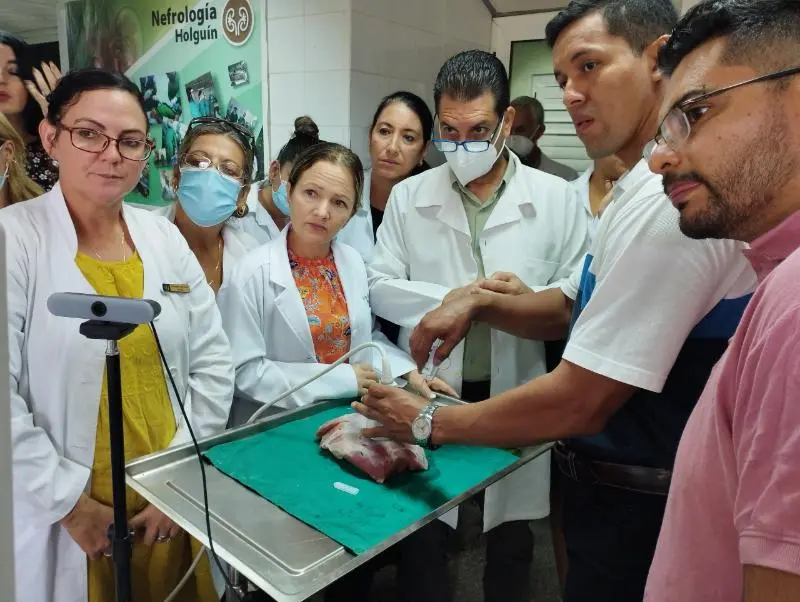
The relatively recent appearance of Interventional Nephrology is about combining ultrasound techniques with these procedures so that it is through ultrasound that all these procedures are guided. For example, if we are going to perform a renal biopsy, we can see the kidney and at the same time we can see how the needle is entering the skin, how it is approaching the kidney, in which part of the kidney. This, of course, gives us an incredible margin of safety. For us it makes all these procedures of placing catheters or performing biopsies much faster and safer for the patient”.
The relatively recent appearance of Interventional Nephrology is about combining ultrasound techniques with these procedures so that all these procedures are guided through ultrasound. For example, if we are going to perform a renal biopsy, we can see the kidney and at the same time we can see the needle as it enters the skin, how it approaches the kidney, where it is in the kidney.
Ultrasound, practice, nephrology, course, Interventional Nephrology, course
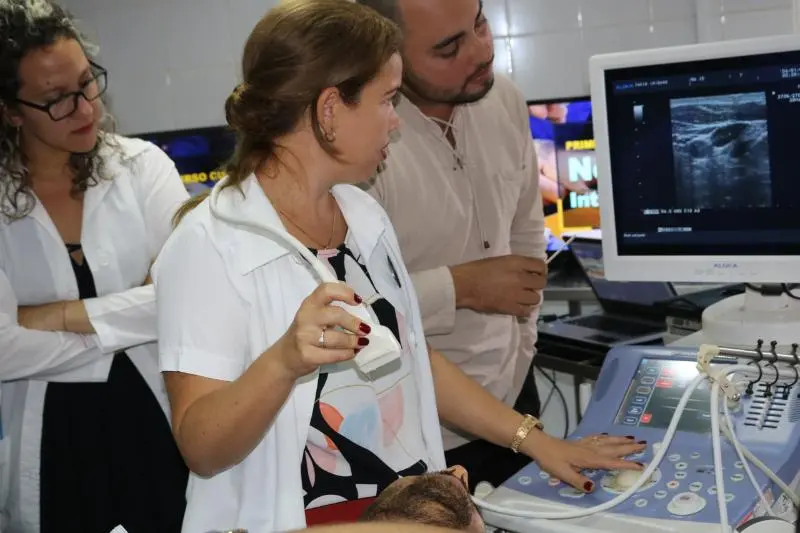
How many opportunities does the fellowship granted by the International Society of Nephrology offer?
-Since the year 2021, the International Society of Nephrology promotes the development of interventional nephrology in this type of subspecialty in settings with limited resources, such as Latin America, through a scholarship program for nephrologists from these centers to train in developed centers.
It was in the year 2022, in the second edition of this scholarship when the International Society of Nephrology chose me to perform a three-month advanced training at Ignacio Chávez National Cardiology Institute in Mexico City.
All the necessary arrangements were made, I agreed to my trip and the society paid for my travel and so on, and I have been training myself in this regard. Since I returned, we have modified the hemodialysis scenario, for example, we use two catheters, one known as transitory, which is used for a maximum period of two weeks, and the permanent catheter, which can be used for a period of up to years. The latter greatly reduces the risk of infection, which is the main cause of the catheter having to be removed, the patient becoming complicated and even dying from septic shock due to infection.
When we returned from the fellowship in February the panorama changed, all our patients had transient catheters, even though they had been on hemodialysis for several months, which meant that they were frequently infected and the dialysis sessions were complex because they always had chills, fever, vomiting and felt very bad.
When we arrived, we began to use ultrasound in the hospital, they put a device at our disposal so that we could begin to locate the veins by this means”.
Cuban course, interventional nephrology, Holguín

What are the advantages of using Interventional Nephrology?
-Once I received this training in Mexico, in a short time the situation with peritoneal dialysis and hemodialysis patients was reversed. While before it was necessary to perform four or five punctures to find the vein, it became a single puncture because we could see the vein and the needle in the direction of the vein. It became a faster procedure and much safer for the patient, to the point that complications practically disappeared.
In these patients, the main benefit is that the multiple transient catheters that the patients had became permanent catheters, to the point that now all our patients have permanent catheters. This has significantly reduced catheter-associated infections, the need for catheter removal.
Likewise, when a kidney biopsy had to be performed, the needle was introduced through the back towards the kidney, all this blindly without knowing the real position of the kidney and without seeing the needle could compromise the patient’s life”.
cuban course, interventional nephrology, Holguín
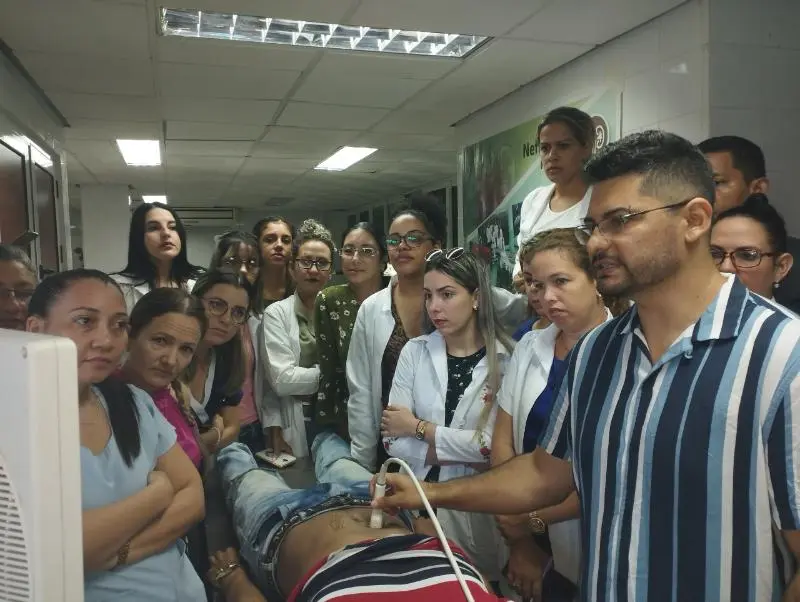
How did the idea of this First Course on Interventional Nephrology arise and take shape?
-On the recommendation of the International Society of Nephrology, this in turn becomes a training for the rest of the physicians. We designed a course that had a hybrid modality. In the first week, five theoretical lectures were given on procedures related to how to place a catheter for hemodialysis, for peritoneal dialysis, how to perform a renal biopsy and how to use ultrasound for all these procedures. In these sessions we had some international lecturers from Mexico and Ecuador, which raised the endorsement and scientific impact of this activity.
Thanks to the support of the International Society of Nephrology, funds were granted to an Ecuadorian doctor who is an expert in interventionism to travel and participate in the practice sessions. He is Dr. Juan Cristóbal Santa Cruz Mancheno, with a follow-up by this society that is giving merits and academic credits.
cuban course, interventional nephrology, Holguín
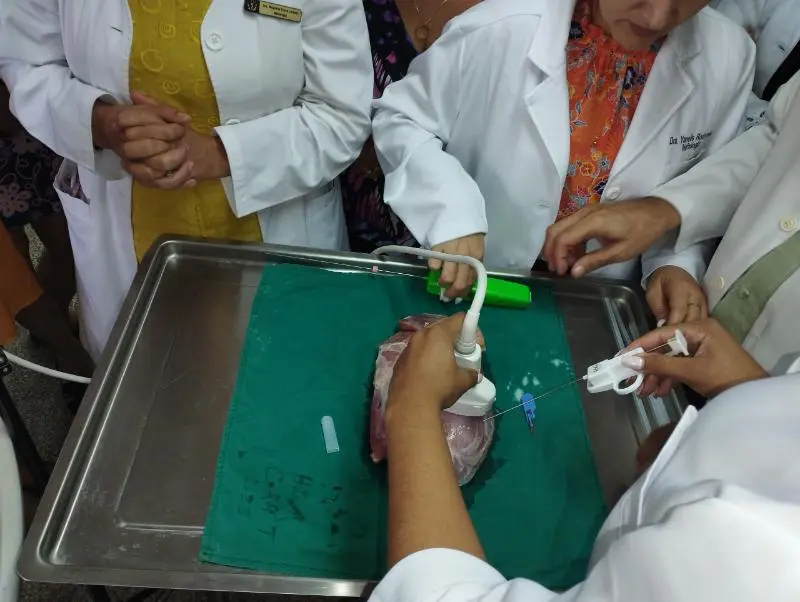
In the week that concludes we developed the practical activities, the nephrologists acquired the theoretical knowledge, but they are procedures that need the acquisition of practical skills. On Monday itself, the practical activity began with an ultrasound equipment that was made available to us to begin to explore and for the doctors to become familiar with the use of ultrasound, as well as to see the deep veins, the heart, kidneys and fistulas of the patients.
For this activity we created a mock-up with beef, we created a mock-up to which we introduced a kind of hose to simulate the deep veins. The doctors, using real-time ultrasound, tried to reach the vein with a long needle. They also used a pig abdomen where they practiced how to place the peritoneal dialysis catheter and some kidneys placed inside segments of pork or beef so that by means of ultrasound they could locate these kidneys, and in real time they introduced the needle to take a sample for renal biopsy.
An alternative is the use of mock-ups created in the context itself, despite the limitations for nephrologists to learn in a safe way for patients. This use of mock-ups is very functional because it simulates very well what is intended. There are countries that have simulators, with a cost that exceeds 50 thousand USD, in our environment this is not feasible, therefore we use beef or pork and pork kidneys.
So the nephrologists practice in a real scenario because it is simulating very close to the truth. The fact that they are mock-ups on simulators that we created gives you the ability to correct the mistake that you made. If you inserted the needle in the wrong direction, you can remove it and then reposition your ultrasound to get a good image of the organ you are puncturing and start again.
When in a real-life patient we can only perform two punctures on the kidney to make it safe even with a very high risk of complications, in these simulators we have, you can perform as many punctures as you wish, because there is no risk of complication and you are acquiring a practical skill.
On Friday, a closing round table discussion was held on strategies to improve this subspecialty that is Interventional Nephrology in our scenario and context. Although it is true that there are limitations to perform hemodialysis, it is important to recognize that we have never failed to incorporate patients who need it”.
cuban course, interventional nephrology, Holguín
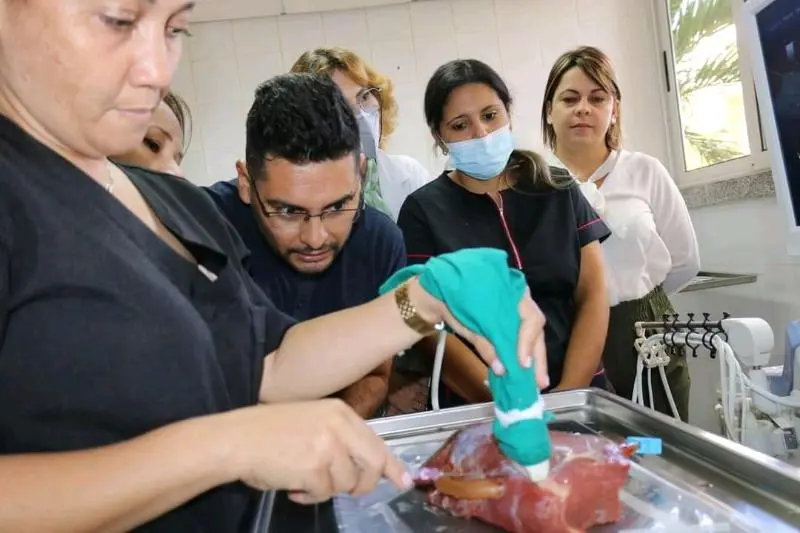
What is the impact of this course among Nephrology professionals?
-Since this is the first time it has been done in Cuba, we have had the recognition of the Cuban Society of Nephrology and the National Institute of Nephrology. We even have nephrologists from the renowned Hermanos Amejeiras Hospital who trained with us, which gives impact and value to what we are doing. A Honduran nephrologist who did his residency in Cuba and works in the capital also participated and came to train with us.
This is a milestone and must have a very positive impact on the health of the patients, because the nephrologists are being trained to perform these procedures, which although they are invasive and risky, they are being trained to do it in the safest possible way.
So when they return to their dialysis centers they will be able to perform invasive procedures more safely, with the guarantee of well-being for the patients. This translates into fewer complications for the patients, procedures that are stressful and will be done in a more adequate time, because the nephrologists are trained in how to use ultrasound, which saves time and safety. The positive social and medical impact on patient health and safety is evident.
- Systemic Sclerosis, a Disease in Need of Publicity - 1 de July de 2025
- Holguin with the first Center for Research Resources in Health - 28 de June de 2025
- Activities in Holguin for the International Day against Drug Abuse - 26 de June de 2025
